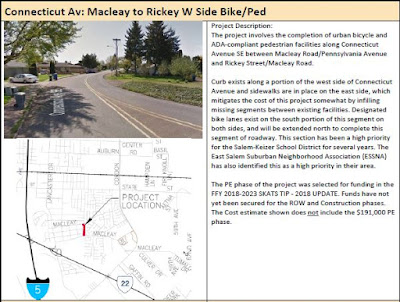Andy Bryant, hydrologist for the National Weather Service in Portland, said the weather service has no record of a flood event in the southern Willamette Valley occurring this late in the rainy season.So while this is an instance of weather, not climate, it is reasonable to think its lateness can partially be ascribed to climate change, a partial effect of climate disruption, and something of which we may be seeing more.
“The time of the year, just in my mind, makes it historically significant, that we’re having a flood like this a week into April,” he said.
Bryant added: “It’s very unusual to have this kind of heavy rain in April. What we’ve had is more of a November through February kind of weather event.”
 |
| Tuesday front page |
 |
| Start of draft RTSP (yellow in original) |
So at this point is it possible to start outlining main threads on the RTSP. The Executive Summary offers one of them. It's a very clear expression of hydraulic autoism, and they've even left a relevant portion in yellow: "The anticipated increase in travel demand will put pressure on each component of the regional transportation system..." It's all about inexorable growth of fluid and the pressure that follows.
It's not about safety, it's not about the movement of people and goods (as distinct from cars), it's not about climate and pollution. It's about fluid pressure.
This remains a great theoretical problem in our high-level concepts and planning for transportation.
And it hampers our ability to grapple with the problem of carbon pollution.
 |
| 57% percent of CO2 is from our transportation! (April 3rd "Our Salem" Presentation) |
- Shifting away from hydraulic autoism
- And related, moving off of "Levels of Service" analysis
- Thinking more about Goal 7, greenhouse gas emissions, and climate - especially since the latest estimate is that 57% or more of our emissions come from transport
- Rooting out vestiges of the SRC and its ancillary projects. We've seen how in Portland ODOT was able to smuggle into the I-5 Rose Quarter analysis hidden assumptions from the Columbia River Crossing project. ODOT or the MPO might do the same here.
- Generally boosting walking, biking, busing, and things like Safe Routes to School programming
 |
| List of candidate projects to score and vet |
There's about $15 million available, and applications for more than twice that amount.
If we enjoyed surpluses on transportation budgets during the Great Recession, we are now firmly in a phase of deficits, and at the top of the list are four projects that have run over budget and for which additional funding is needed. Fortunately there appears to be an obvious solution:
We were recently notified that SKATS will be receiving $1,159,979 in Highway Improvement Program (HIP) funds. These are quick turnaround funds and must be obligated by September 2022. Should the HIP funds be used to fund the project shortfalls?The implied answer is "yes."
Ranking the other projects may be more difficult.
At the top are some projects that seem over-engineered. Two of them take stroads that are already zoomy and propose to make them much wider and more zoomy.
 |
| Take Center Street to five lanes |
 |
| Take State Street to five lanes |
So, let's see, if we widen the road, induce many more car trips, all at a higher rate of speed, this is going to attract more walking and biking? Yeah, sure, that'll work.
This is the logic of simply drawing lines on a map.
Additionally, on the State Street project, widening this part will add traffic to the part in town where we would like a full 4/3 safety conversion. This project is not consistent with our goals on the State Street study. There's a disconnect. (See below for more.)
We also have some deferred maintenance.
 |
| Reconstruction on Lancaster |
 |
| Sidewalks and bike lanes on Connecticut |
 |
| Sidewalks on Orchard Heights |
 |
| Bike crossing at Salem Parkway |
 |
| Bike lanes and sidewalks on Broadway |
 |
| An infamous missing section of sidewalk on Commercial |
 |
| Enhanced crosswalks on River Road and Lancaster |
 |
| Safe Routes to School programming |
 |
| Enhanced crosswalks on State Street (and not consistent with the five-lane widening project) |
But just generally, we are at a point where we should be promoting walking, biking, and busing projects, and should give much less consideration to auto capacity projects.
If there is a problem with "pressure," it comes from CO2, not from more travel demand for drive-alone trips.
 |
| Look for the historic sign next to the entry |
SKATS Technical Advisory Committee meets Tuesday the 9th, at 1:30pm. SKATS is at 100 High St. SE, Suite 200, above Table Five 08.



No comments:
Post a Comment